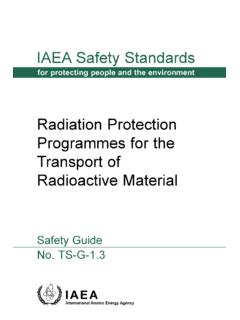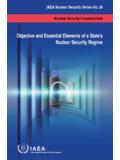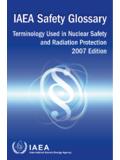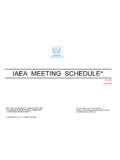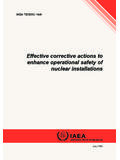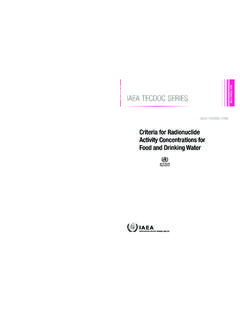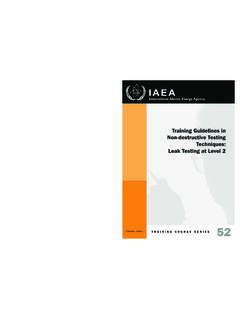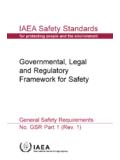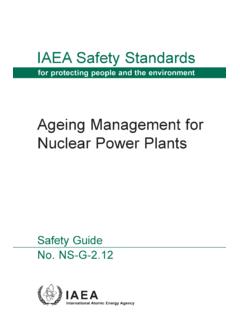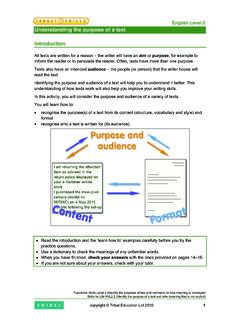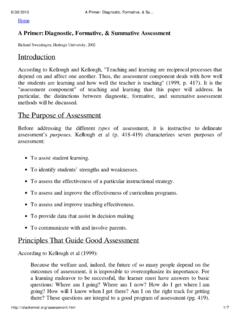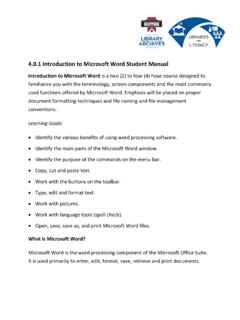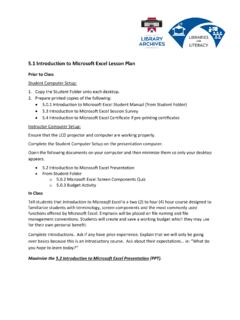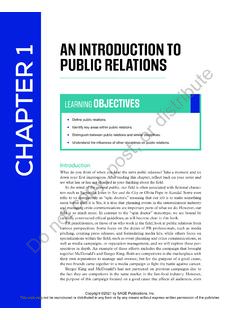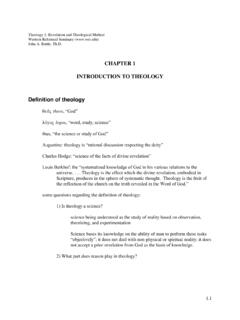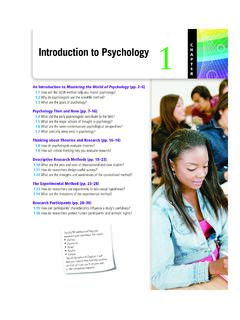Transcription of Section 1: Introduction to Quality Management
1 Introduction to Quality Management for EDXRF practice - Pursuing ISO/IEC 17025:2005 accreditation. Section 1: Introduction to Quality Management 1 1 Introduction TO Quality Management This Section will provide you with examples on how to implement actions in your Quality Management program to pursue the fulfilment of the ISO 17025 requirements. Some examples are provided for illustration on how to implement actions for the particular case of XRF analytical practice. THE GOAL OF Quality Management To lead and operate an organization successfully, it is necessary to direct and control it in a systematic and transparent manner. To be really efficient and effective, your XRF Laboratory can manage its way of doing things by systemizing it, even when you do not perform a routine work.
2 This ensures that nothing important in your XRF practice is left out and that everyone is clear about who is responsible for doing what, when, how, why and where. Success can result from implementing and maintaining a Management system in the XRF Laboratory, designed to continually improve performance while addressing the needs of all interested parties (customer and supplier). MANAGING AN ORGANIZATION ENCOMPASSES Quality Management (QM) AMONGST OTHER Management DISCIPLINES. THE EARLIEST DEFINITION OF Quality The earliest definition of Quality probably occurs in early Introduction to Quality Management for EDXRF practice - Pursuing ISO/IEC 17025:2005 accreditation. Section 1: Introduction to Quality Management 2 THE DEFINITION OF Quality AS CONSENSUALLY AGREED BY 2005 (ISO 9000) "The degree to which a set of inherent characteristics fulfils requirements" Quality can be used with adjectives such as poor, good, 'Inherent', as opposed to 'assigned '', means existing in something, especially as a permanent Requirement': A need or expectation that is stated, generally implied or obligatory Stated means usually explicitly in a document.
3 Generally implied means that it is custom or common practice for the organization, its customers and other interested parties. Requirement is the expression in the content of a document conveying criteria to be fulfilled if compliance with the document is to be claimed and from which no deviation is permitted. THE DEFINITION OF Quality APPLIED TO ANALYTICAL LABORATORIES In the case of a laboratory providing analytical results, Quality can be understood as the degree of compliance to the requirements of the customers. Therefore, the customer shall be requested to be specific in regard to: what type of material has been brought for analysis? The type of material (sample matrix) will allow to define the type of interferences that can be expected, the expected detection limits (since there will be more or less attenuation/scatter/enhancement effects), the availability of calibration or not, among other figures of performance.
4 Which elements need to be analyzed? The list of required elements will address the analyst into the selection of proper excitation/measurement conditions. what is the expected concentration/weight fraction of the elements in the sample? The stated concentration/weight fraction allows to select a method with sufficient sensitivity and detection limits. what is the expected uncertainty for the results? One of the main figures to define the fitness of a given method for the purpose the results are expected. ISO 9000:2005. LOOKING FOR A CONSENSUS The ISO 9000 family of standards represents an international consensus on good Quality Management practices. It consists of standards and guidelines relating to Quality Management systems and related supporting standards.
5 ISO 9000 standard series was developed to assist organizations, of all types and sizes, to implement and operate effective Quality Management systems. ISO 9000:2005 DEFINES GENERAL, FUNDAMENTAL ISSUES. Introduction to Quality Management for EDXRF practice - Pursuing ISO/IEC 17025:2005 accreditation. Section 1: Introduction to Quality Management 3 ISO 9000:2005 CONTENTS Fundamentals:o Rationale o Requirements for QMS o Requirements for products o QMS approach o Process approach o Quality policy and Quality objectives o Role of top Management o Documentation o Evaluation of QMS o Continual improvement o Role of statistical techniques THE EIGHT QM KEY PRINCIPLES Terms and definitions Customer focus Leadership People involvement Process approach System approach to Management Continual improvement Factual approach to decision making Mutually beneficial supplier relationships QM KEY PRINCIPLES.
6 CUSTOMER FOCUS Organizations depend on their customers and therefore should understand current and future customer needs, should meet customer requirements and strive to exceed customer expectations. THE CUSTOMER IS ALWAYS RIGHT! Introduction to Quality Management for EDXRF practice - Pursuing ISO/IEC 17025:2005 accreditation. Section 1: Introduction to Quality Management 4 QM KEY PRINCIPLES: LEADERSHIP Leaders establish unity of purpose and direction of the organization. Leaders should create and maintain the internal environment in such a way that people can become fully involved and committed in achieving the organization's objectives. QM KEY PRINCIPLES: PEOPLE INVOLVEMENT TO BECOME A REAL LEADER, NOT JUST THE BOSS!
7 People at all levels are the essence of an organization and their full involvement enables their abilities to be used for the organization's benefit. IT S EVERYBODY S BUSINESS. UNITY MAKES STRENGTH. Introduction to Quality Management for EDXRF practice - Pursuing ISO/IEC 17025:2005 accreditation. Section 1: Introduction to Quality Management 5 QM KEY PRINCIPLES: PROCESS APPROACH A desired result is achieved more efficiently when activities and related resources are managed as a process. PROCESS APPROACH IS BASED IN THE PDCA PRINCIPLE: PLAN DO CHECK ACT QM KEY PRINCIPLES: SYSTEM APPROACH TO Management Identifying, understanding and managing interrelated processes as a system contributes to the organization's effectiveness and efficiency in achieving its objectives.
8 Introduction to Quality Management for EDXRF practice - Pursuing ISO/IEC 17025:2005 accreditation. Section 1: Introduction to Quality Management 6 QM KEY PRINCIPLES: CONTINUAL IMPROVEMENT Continual improvement of the organization's overall performance should be a permanent objective. WE ARE BUT WE CAN BE EVEN BETTER! QM KEY PRINCIPLES: FACTUAL APPROACH TO DECISION MAKING Eff ective decisions are based on the analysis of data and information. QM KEY PRINCIPLES: MUTUALLY BENEFICIAL SUPPLIER RELATIONSHIPS WE BELIEVE IN BUT MUCH MORE IN THE FACTS. An organization and its suppliers are interdependent and a mutually beneficial relationship enhances the ability of both to create value. ONE HAND WASHES THE AND BOTH WASH THE BODY!
9 Introduction to Quality Management for EDXRF practice - Pursuing ISO/IEC 17025:2005 accreditation. Section 1: Introduction to Quality Management 7 KEY ELEMENTS IN Quality Management Quality Management CONNOTATIONS Ethic value (performing at own best effort!). Documented procedures and records help to ensure traceability and dependability. Mutually beneficial outcome for supplier and customers. Customer satisfaction increases. Supplier organization efficiency, competence and capabilities enhance continuously. OTHER RELEVANT Quality STANDARDS FROM THE ISO 9000 SERIES: ISO 9001:2000. Quality Management Systems Requirements. ISO/IEC 17025:2005. General requirements for the competence of testing & calibration laboratories.
10 Introduction to Quality Management for EDXRF practice - Pursuing ISO/IEC 17025:2005 accreditation. Section 1: Introduction to Quality Management 8 Introduction TO THE ISO 9001:2000 Meet customer needs and expectations and ISO 9001:2000 Quality Management Systems Requirements ISO 9001:2000 is an international standard that gives requirements for an organization's Quality Management System (QMS). It is the only standard in the ISO 9000 family that can be used for the purpose of conformity assessment. The objective of ISO 9001:2000 is to provide a set of requirements that, if effectively implemented, will provide you with confidence that your XRF Laboratory can consistently provide analytical services that: Comply with applicable regulations.
